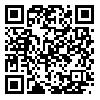BibTeX | RIS | EndNote | Medlars | ProCite | Reference Manager | RefWorks
Send citation to:
URL: http://shenakht.muk.ac.ir/article-1-346-en.html
Background and aim: Depression is a recurrent disorder with implications for social, economic, physical and psychological aspects. One of these negative consequences is the eating disorders. Therefore, this study was performed to investigate the relationship between body image and cognitive distortions, with anorexia and bulimia nervosa in patients with depression.
Method: This was a descriptive correlational study. The study population consisted of patients with depression who referred to psychiatry and psychology clinics in the city of Ardabil in 1395. In the random sampling stage, 41 patients (26 patients with anorexia and 15 with bulimia nervous) were selected.To gather information using the scale of Ahvaz Eating Disorders, fear of Littleton body image and interpersonal cognitive distortions were used. To analyze the data, Pearson correlation coefficient and multiple regressions were used. SPSS statistical software was used for this purpose.
Results: A significant negative relationship was found between body image and Anorexia and Bulimia nervosa, while a significant positive relationship was found between cognitive distortions (in all its aspects) and Anorexia and Bulimia nervosa. Regression analysis showed that body image and cognitive distortions can predict Anorexia in 36% of the patients with depression, whereas the predictability of Bulimia Nervosa was 40%.
Conclusion: These results show when there is a problem with body image and cognitive distortions, this could increase eating disorders (anorexia and bulimia)
Received: 2017/05/9 | Accepted: 2017/09/12 | Published: 2017/09/12
| Rights and permissions | |
 |
This work is licensed under a Creative Commons Attribution-NonCommercial 4.0 International License. |





